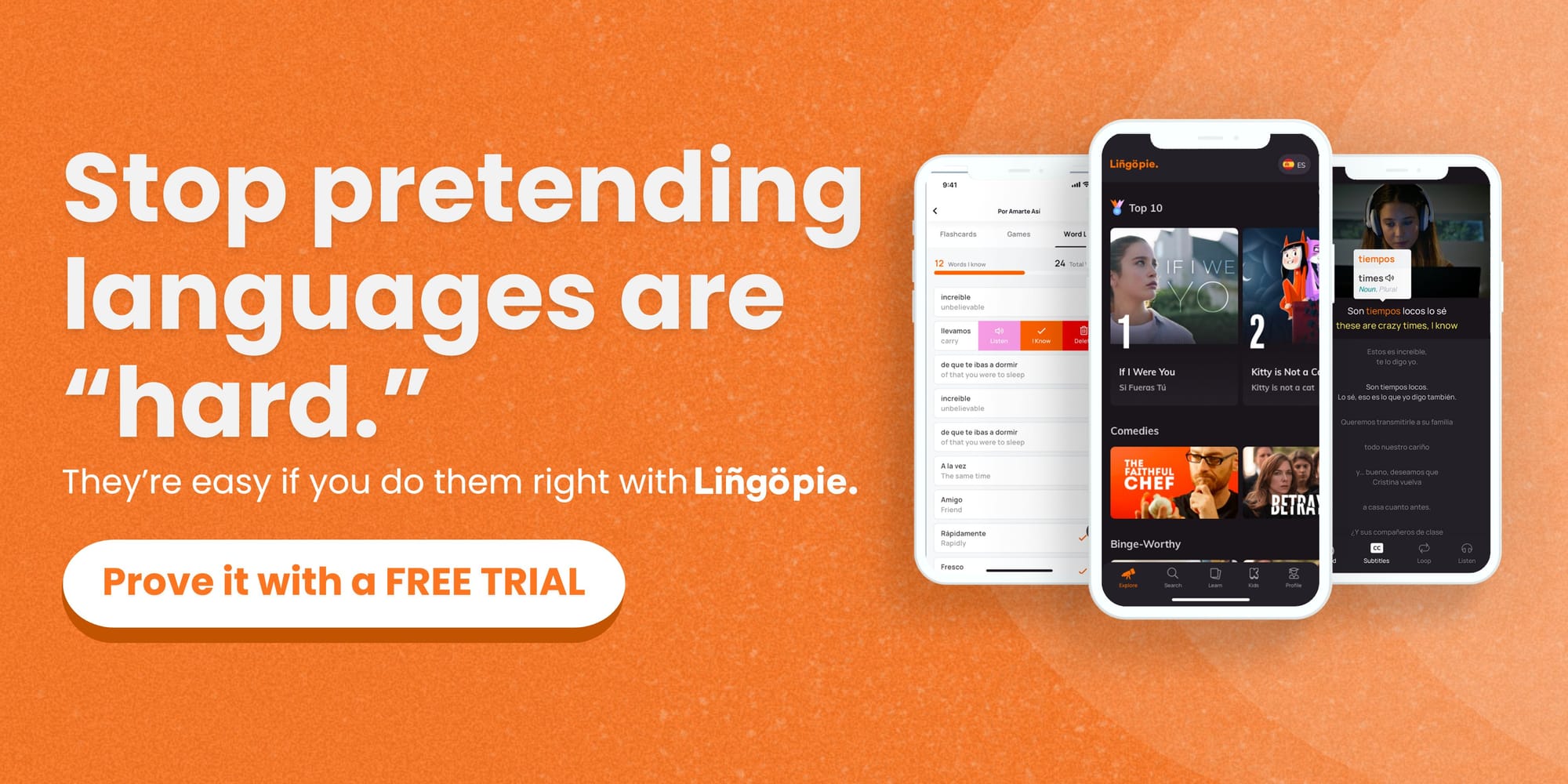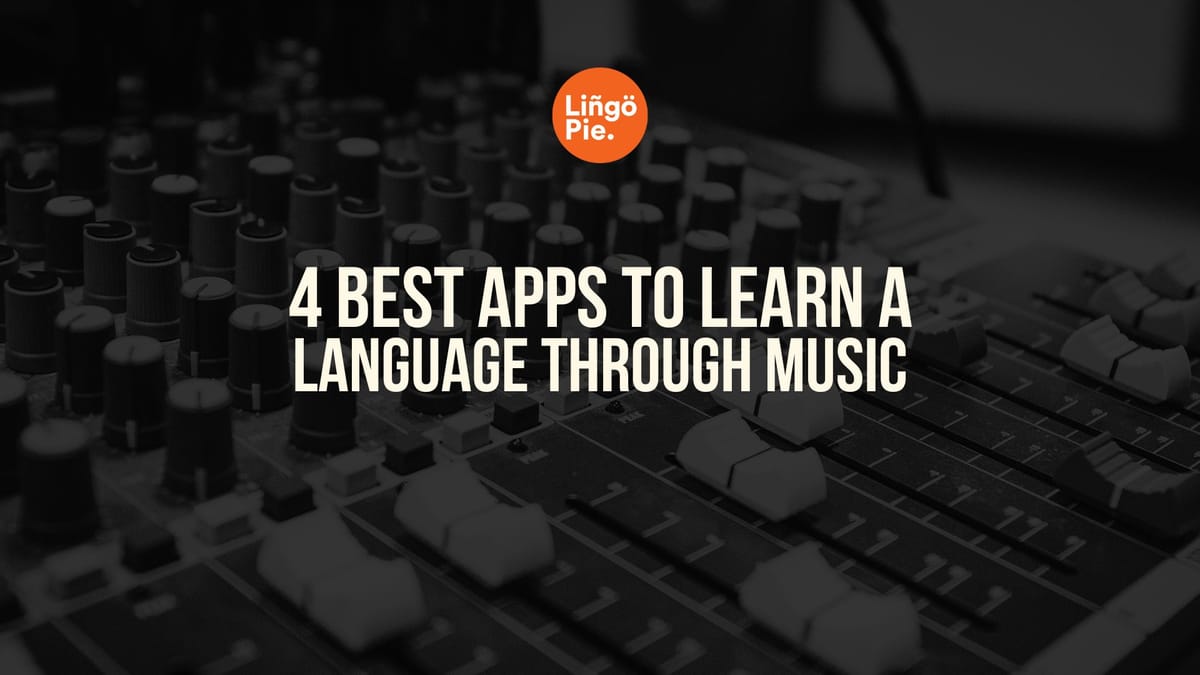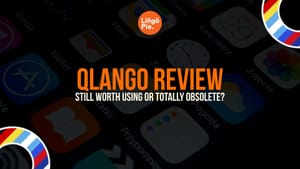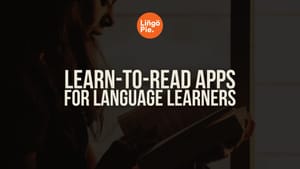We’re spoilt for choice when it comes to language learning, aren’t we? From gamified apps to AI tutors promising you’ll be fluent by next Tuesday, there’s no shortage of bold claims. But when it comes to actually having a real chat with a native, many fall short. That’s why I gave Lingoda Spanish a proper go — to see if this premium online language school really delivers more than flashy promises.
I won’t lie, the Lingoda cost can make you wince, especially if you’re used to free apps. So is it worth digging deeper into your pocket for their live classes? After a few months on the platform, here’s my honest take on whether Lingoda’s structured lessons, native teachers, and flexible schedule are worth it — or just another pricey promise.
- Mondly Review: Does Pearson’s AI-Powered App Live Up to the Hype?
- 5 Best Learn-To-Read Apps For Language Learners
- Pimsleur Review: Why I Quit This "Proven" Method After 6 Months

What Is Lingoda?
Lingoda is an online language learning platform that brings real-life conversation into your living room (or wherever you’ve got Wi-Fi). Founded in Berlin back in 2013 by two brothers, Fabian and Felix Wunderlich, Lingoda’s mission is to build bridges around the world through language. And they’ve made quite a dent with over 100,000 students from nearly 200 countries!
What makes Lingoda different from your typical app is its core focus: live online classes with native speakers. You sign up for a monthly subscription, pick your times, and jump into small-group or 1-on-1 lessons. Think virtual classrooms where you can ask questions, practise pronunciation, get instant corrections, and participate in discussions with other language learners.
In my experience, having native speakers guide you is one of Lingoda’s biggest strengths. You hear real accents, pick up natural phrases, and get corrected on the spot so mistakes don’t stick. It really feels like a mini immersion every class. That said, not everyone wants that kind of structure and face-to-face interaction.
Some people genuinely learn better with bite-sized, gamified apps like Duolingo that they can squeeze in anytime. It really just comes down to what your learning style is and what keeps you motivated.
How Does Lingoda Language Learning Work
Class Structure And Duration
Lingoda’s live classes run for a full 60 minutes via Zoom, though it’s normal for teachers to wrap up a few minutes early if they’ve got back-to-back sessions. You can book private one-on-one lessons or choose small group classes, capped at three to five students. Each has clear perks, so it really depends on how you like to learn.
Group Classes
Group classes cost a lot less per session, and they bring a social angle you just don’t get with solo apps. Once you're in, you can expect to feel like you're in a mini United Nations, hearing how someone from Brazil might pronounce German differently than a student from Japan. You learn from your classmates’ mistakes too, and because the groups are so small, everyone still gets speaking time and direct feedback.
Private Classes
If you’d rather zero in on your own weak spots, private classes are worth the extra spend. You’ve got the teacher’s full attention to tackle tricky grammar, polish a cover letter, or prep for a big work presentation. It’s also a confidence boost if you’re shy about speaking up in a group.
Personally, I found private sessions really handy when I needed to nail specific pronunciation issues fast. If you’re on a budget, I highly recommend sticking with small groups to get that solid real-world practice without breaking the bank.

Flexible Scheduling
Lingoda runs 24/7, which makes scheduling classes incredibly easy, no matter what time zone you’re in. Whether you want to squeeze in a quick Spanish session at 6 am or unwind with a German class at midnight, there’s almost always a native-level teacher available. Your dashboard automatically shows all class times in your local time zone, so you’re never second-guessing when to log in.
If something comes up, you can cancel group or private classes up to three days in advance and keep your credit. Personally, this feature of Lingoda classes is what I like the most because it lets me plan my week around work and still fit in learning. That said, you do need to be smart about booking. The most popular slots and grammar-specific classes fill up fast, so I learned to schedule lessons at least a week in advance. It’s great freedom, but it’s easy to let things slide without a set routine.

Native-Speaking Teachers And Immersion
One of Lingoda’s biggest selling points is that all its teachers are native speakers and certified professionals. From day one, you’re learning almost entirely in your target language — no switching back to English for an easy shortcut. This immersive approach means you get used to real pronunciation, natural expressions, slang words, and different accents.
Whether you choose private or group classes, teachers use structured materials and often make annotations live on-screen, which you can review later. After each lesson, you’ll usually get a quick summary or feedback, sometimes with personalised tips on what to work on next. Plus, you get to rate your teacher, which helps keep the quality in check.
In my first week trying Lingoda group classes, I remember feeling a bit overwhelmed because I kinda of felt that I was thrown into the deep end without much exposure to the language. I mean, I tried it with French, and the only thing I knew then was how to introduce myself. Luckily, the teacher spoke really slowly and gave actual tips and translations during our sessions. By the end of class, I managed to create a list of basic vocabulary and useful expressions.
But here's the thing, though...
Keep in mind that not every teacher will click with your learning style. Some are great at grammar drills, while others focus more on free-flow speaking. So, it can take a few tries to find teachers whose style matches what you need most. My tip? Try a mix and stick with the ones that help you feel challenged but comfortable.

Curriculum and Materials
Lingoda’s entire curriculum is built around the internationally recognised CEFR framework, which maps your skills from absolute beginner (A1) through to advanced (C1). Each level is split into clear chapters with lessons that mix competencies like speaking, conversational practice, reading, writing, and listening. Pretty holistic, don't you think?
One thing I really rate well is that lessons come with course materials and downloadable PDFs. These include slides, vocabulary lists, and extra reading so you can prep before class and review afterward. As a competitive person taking group lessons, I sneak in a few minutes ahead of time so I can review the topics for the day and prepare my questions (if there are any) for the teacher ahead of time.
Another thing worth pointing out is that the lessons are structured but still flexible. For instance, if I want to focus on learning expressions and basic sentence patterns for my upcoming trip, I can specifically take the group lessons (along with the lesson materials). I did that when I tried Lingoda French, and the sessions I had leading up to the day I visited Paris were worth it! However, note that I still used other language-learning apps to really strengthen my language skills.
Progress Tracking and Certificates
Lingoda makes it pretty easy to keep tabs on your progress. Everything’s structured around CEFR levels, so you always know exactly where you stand. There are no stressful final exams or nerve-wracking oral tests — instead, once you complete 90% of a level (that’s 45 out of 50 lessons), you can automatically download your CEFR-aligned certificate.
These certificates show your proficiency across reading, writing, listening and speaking, and may be used for boosting your CV, LinkedIn or a job interview where you want to show proof of your language level without jumping through extra hoops.

But here’s the reality check...
For some official purposes, especially if you’re learning German, you’ll likely need more than just Lingoda’s certificate. For example, universities and visa offices often want gold-standard exams like Goethe, TELC, or TestDaF for German. Employers may accept a Lingoda certificate as evidence of your skills, but for permanent residency or uni admission, you’ll need to check what’s required.
In my opinion, Lingoda’s certificates are perfect as a clear progress marker and a legit add-on for your professional profile. They show you’re consistent and serious about your language learning. Just don’t bank on them alone if your end goal is a visa or an official study program.
Lingoda Sprint
One of Lingoda’s most talked-about features is the Sprint and Super Sprint. With Sprint, you commit to 15 classes a month, while Super Sprint doubles that to 30 classes a month. The big carrot? Nail perfect attendance and follow the rules to earn up to 50% of your money back, either as cash or class credits.
Miss more than 10 minutes of a class? You’re out. You can’t take more than one class a day, and in regular Sprint, you’re limited to five per week. That means if you sign up for Super Sprint, you’re basically committing to a class every single day for two months. Factor in prep and review time, and you’re looking at a serious daily workload!
For me, the regular Sprint is brilliant for quickly building solid habits. You get daily speaking practice, consistent feedback, and a big motivation boost thanks to that cashback reward. But it’s not for everyone. If you know you’ll struggle to carve out an hour every day — or you’re juggling a busy work or family schedule — the regular Sprint with 15 classes a month might be more realistic.

Lingoda Review Pros
Convenient Scheduling
Lingoda’s 24/7 schedule is a big advantage if you have a busy life or live in a time zone that rarely matches traditional class hours. Because Lingoda has teachers all over the world, you can literally learn any time. You can also book classes months in advance to build a routine or grab a last-minute session if you find a free hour.
In my experience, this genuine flexibility helps reduce stress and lowers the affective filter. When you learn at a time that suits your energy levels, you’re more focused, more relaxed, and more likely to stick with it long term.
Real Native Speakers
All Lingoda teachers are native-level speakers (not some AI voice) who also hold teaching certifications and real classroom experience. They are trained to guide learners through pronunciation and natural expressions that apps often skip. It also means you get feedback that actually makes sense. Instead of memorising stiff textbook phrases, you pick up the words and phrases that real people use.
As someone who taught languages myself, I know that many students underestimate how important teacher quality is until they switch from a basic app. Sure, your app may have streaks or leaderboards, but can it really point out and explain clearly why something is wrong? Like really give explanations and examples?
Ample Speaking Practice
Most people struggle to improve their speaking because they rely too heavily on passive tools like apps or podcasts. Lingoda tackles this problem by getting you speaking in the target language right from your first class. Group sizes stay small, with no more than five students, so everyone has to participate.
Regular speaking reduces the fear of making mistakes and builds the confidence you need for real conversations. You also learn from classmates because you hear how others pronounce words or handle tricky grammar. For me, this active practice makes a huge difference compared to silently drilling vocab alone.
Options For Personalized Lessons
Lingoda’s private class option is a smart way to go deeper when you need extra help. Maybe you want to fix specific grammar mistakes, work on a presentation or polish your pronunciation for a job interview. Private classes mean you have the teacher’s full attention on your unique goals and challenges.
Having this balance between small-group practice and one-on-one focus is what sets Lingoda apart from most online courses. You can stay motivated with the social aspect of group lessons while using private sessions to fix weak spots fast. It gives you control over your progress instead of a one-size-fits-all path.

Lingoda Review Cons
Inconsistent Teaching Styles
One thing that can frustrate many learners is that you rarely get the same teacher twice. While rotating teachers exposes you to different accents and speaking styles, it makes it nearly impossible to build a steady rapport with someone who knows your learning quirks and progress inside out. You lose that continuity that helps some learners feel supported and understood.
It also means teaching quality can vary widely. Some teachers are brilliant at boosting your confidence and improving your speaking flow. Others stick too rigidly to slides, barely adapt to your level, or rush through material just to stay on time. If you value a personal connection with one teacher who adjusts to you week after week, Lingoda can feel scattered.
Insufficient for Self-Study
Lingoda’s lesson PDFs and materials look polished but often feel like they were designed to be used only with live guidance. Many units cram in more activities than can realistically be covered in a 60-minute class, leaving leftover tasks to complete on your own. Without clear instructions or interactive features, these handouts can be confusing for self-review.
If you prefer doing extra work independently to reinforce what you learn, Lingoda’s materials may disappoint you. The slides are static, you cannot easily make notes without third-party tools, and you will find gaps if you rely on them alone. This makes it hard to keep momentum between live classes unless you create your own study plan or add another resource.
Limited Language Offerings
While Lingoda covers English, Business English, German, Spanish, French, and Italian, that is where the choice stops. If you are keen to learn Japanese, Korean, Mandarin, or any less common language, Lingoda will not have what you need. This narrow selection can feel restrictive compared to competitors that offer dozens of languages.
It is also a drawback if you want to switch to a new language without changing platforms. For example, if you finish B2 in Lingoda German and want to try Spanish, you would have to go elsewhere and start over with a new learning system and new teachers. For polyglots or curious learners, this lack of variety can feel like hitting a wall.

Lingoda Prices
Lingoda is not cheap compared to casual alternatives. While the live classes and native teachers justify the cost for many, it can add up quickly if you miss classes or do not use all your credits. The Lingoda super sprint challenge offers a cashback hook, but the strict attendance rules make it risky. Miss one class by more than ten minutes, and your money-back deal is gone.
On top of that, the subscription auto-renews by default, and refunds are not given for unused credits. If you do not manage your bookings carefully, you can end up paying for classes you never take. For casual learners or those who prefer occasional tutoring, platforms like italki or Preply can often be more flexible and cheaper per hour.
Who Is Lingoda Best For?
Lingoda is best suited for learners who want structure, accountability, and lots of real-time speaking practice with professional native-speaking teachers. If you thrive in a classroom-like setting and know you’ll benefit from having regular conversation time with feedback on pronunciation and grammar, Lingoda can be worth every cent.
That said, it is not a one-size-fits-all solution. If you prefer learning by immersion through TV shows, stories, and natural dialogue, a platform like Lingopie is an amazing complement. Lingopie can help you train your ear and build your cultural knowledge in a way that live lessons cannot.
In reality, combining both tools makes sense for most learners — you get the structured speaking practice and immediate corrections from Lingoda and the relaxed, binge-worthy input from Lingopie. That mix is what actually moves you closer to confident, real-world fluency.
Lingoda Alternatives
Lingoda Vs Lingopie

Lingopie’s big draw is immersive video content with real TV shows and movies, but its newer live lessons feature adds an extra layer for learners craving interaction. Unlike Lingoda’s structured CEFR curriculum and professional native-speaking teachers, Lingopie’s live lessons are more conversation clubs or themed sessions run by community tutors or native speakers. They are great for casual practice and cultural exchange, but may lack the consistent progress tracking or qualified teacher input that Lingoda’s live classes deliver.
If you want deep grammar coaching and step-by-step level progression, Lingoda stays ahead. If you mostly want to chat and reinforce what you learn from TV content, Lingopie’s live sessions can be a handy add-on.
Lingoda Vs Tandem

Tandem is popular for its informal, flexible language exchanges. Instead of structured classes, you pair up with other learners or community tutors for chat-based practice, voice calls, or video calls. This makes Tandem a strong social option if you enjoy swapping languages with peers, but it offers no official curriculum, no formal progress tracking, and no guarantee that your partner can teach effectively.
Technically, Lingoda suits you better if you need professional teachers, clear goals, and actual speaking drills with corrections. Many learners use Tandem alongside more formal courses to get extra conversation practice for free or cheap.
Lingoda Vs iTalki

iTalki is one of the biggest marketplaces for finding language tutors, offering huge flexibility in price and teacher choice. You can book lessons with community tutors for conversation or with certified professional teachers for structured lessons. Unlike Lingoda’s fixed curriculum and class slots, iTalki lets you choose the same teacher every time or switch around. It is often cheaper per hour, especially if you only want occasional practice.
However, iTalki lessons vary a lot depending on the teacher’s style, and you do not get the same standardised CEFR roadmap that Lingoda builds in. If you want the freedom to mix tutors and budgets or just drop in for speaking practice, iTalki is a good pick. If you prefer consistency, curriculum, and small-group immersion, Lingoda stays more robust.
Ready To Practice Speaking Like A Pro?
And there we have our complete, comprehensive Lingoda review. As you can see, the Lingoda language program works well if you seriously enjoy live lessons and want steady feedback, but the price, strict attendance rules, and rotating teachers can make it feel less personal or harder to stick with for some learners.
The best alternative? Lingopie!
If you want a more relaxed way to immerse yourself in a new language, watching real TV shows and movies with smart interactive subtitles can make daily learning feel fun instead of like another task. Add in Lingopie’s live conversation clubs when you want to practise out loud, and you have a balanced approach that keeps you motivated. Try Lingopie today and see how it can fit perfectly with other tools to help you speak more naturally and confidently.




![Polish Grammar Basics For Beginners [Guide]](/blog/content/images/2025/07/Polish-grammar.jpg)




![Language Reactor Review: Why Lingopie Is The Better Choice for Language Learning [2026]](/blog/content/images/size/w300/2024/12/Language-Reactor-Review.jpg)